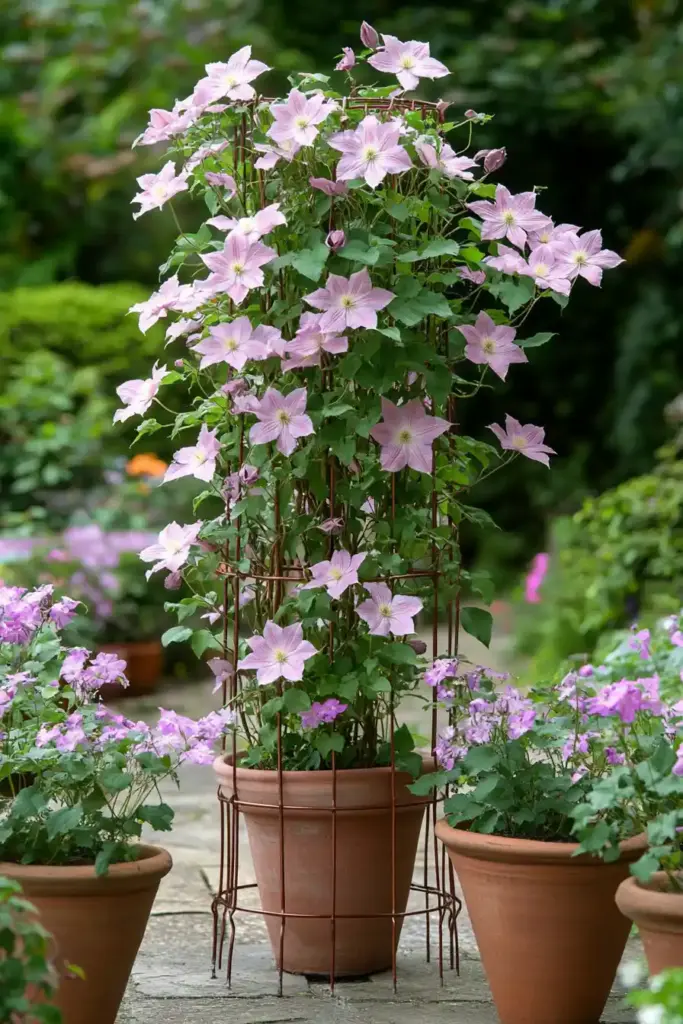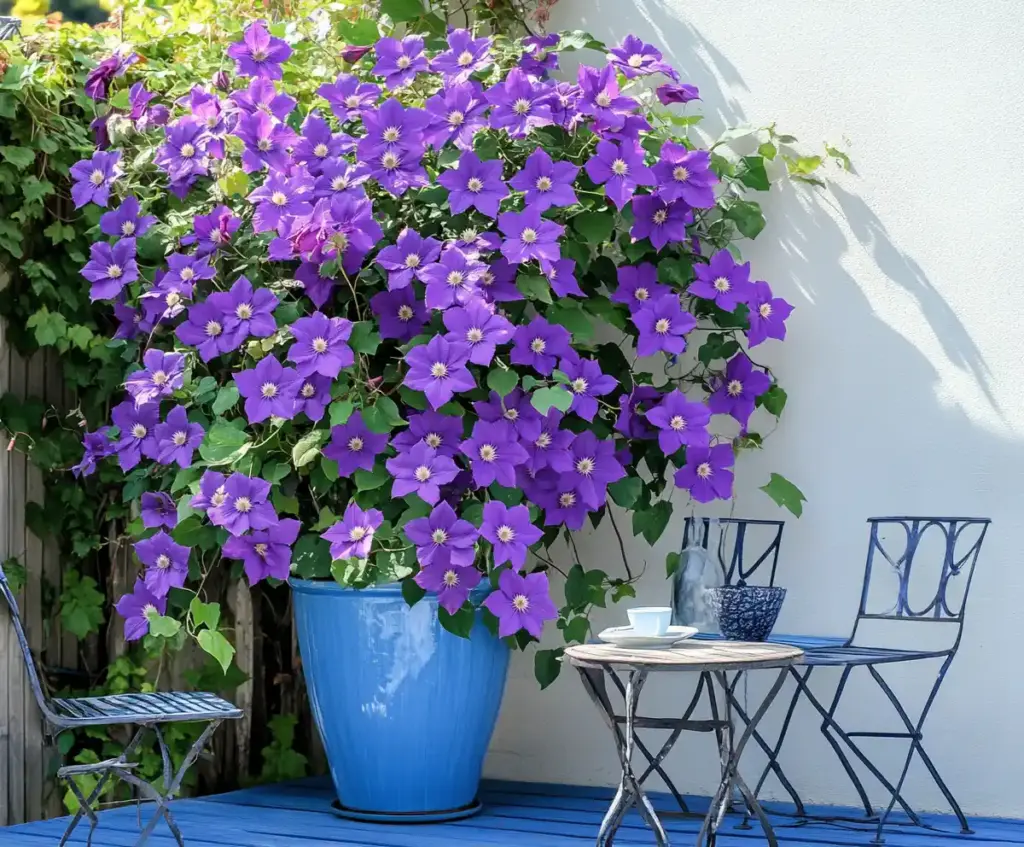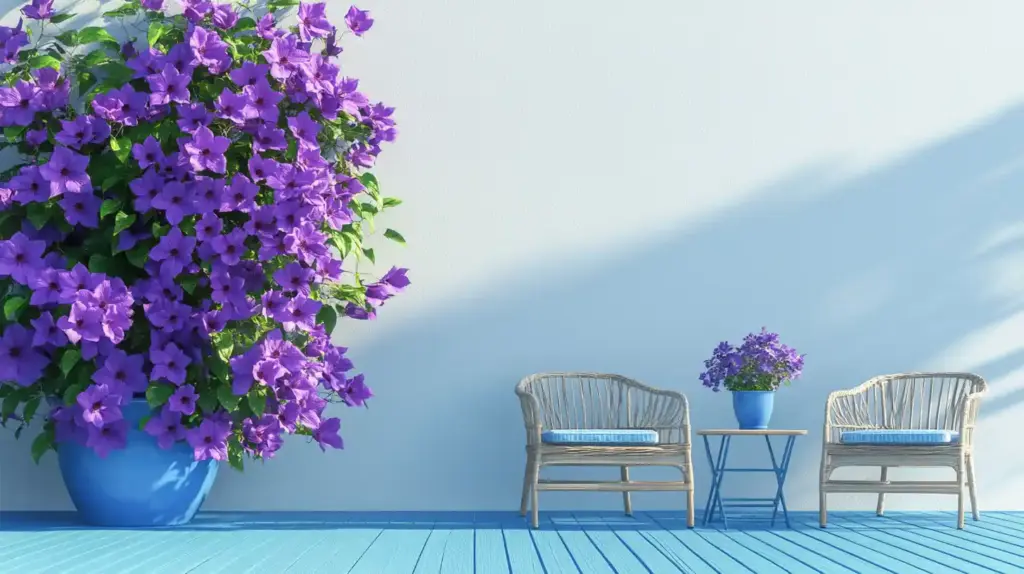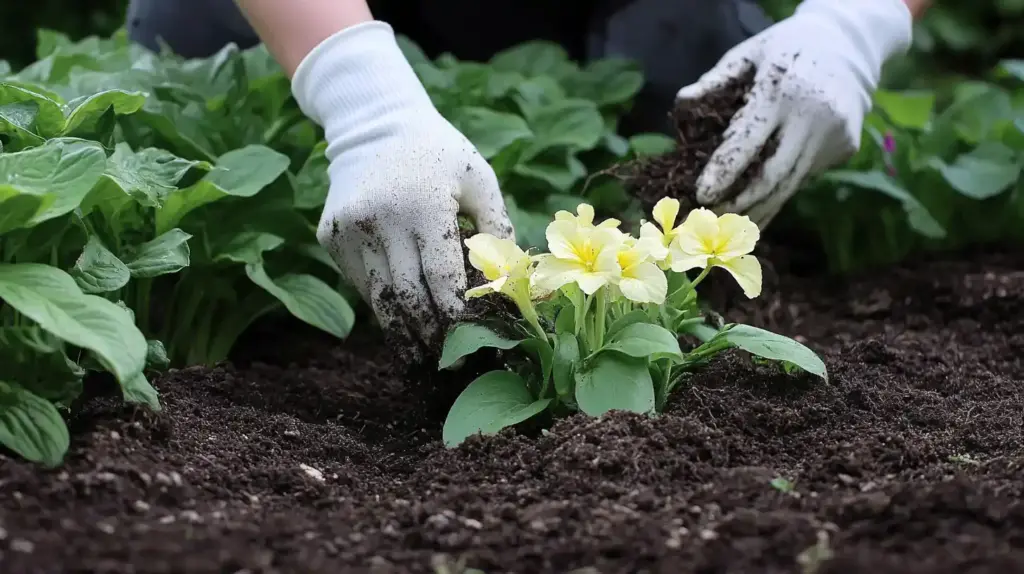If you’re dreaming of vertical color without digging into your landscape, clematis in containers is a beautiful, practical solution. These striking flowering vines, members of the buttercup family (Ranunculaceae), bring an elegant touch to small patios, balconies, and urban gardens. With varieties suited for USDA Zones 5 through 9—and some even hardy to Zone 3—clematis offers beauty and versatility in compact spaces.
Depending on the cultivar, clematis in containers can grow anywhere from 3 to 20 feet tall, producing dazzling blooms in a rainbow of colors. But beyond aesthetics, container planting gives gardeners more control over soil, sun exposure, and mobility. This guide shares everything you need to know about cultivating clematis in pots—plus expert care tips and inspiration to help your container garden thrive.
💡 For more floral design inspiration, check out these 10 inspiring flower garden ideas to complement your clematis containers.
Table of Contents
Benefits of Growing Clematis in Containers

Perfect for Small Spaces and Renters
One of the biggest advantages of growing clematis in containers is flexibility. If you live in an apartment, rent your home, or have limited gardening space, container-grown clematis lets you enjoy climbing blooms without permanent landscaping.
Moveable for Better Sun and Winter Protection
Clematis thrive on sunshine, but they dislike frozen roots. With clematis in containers, you can move your plant to sunnier locations in spring, offer shade in peak summer, and protect it from frost during winter by relocating it to a garage or shed.
Better Root Control and Soil Quality
Clematis can have an aggressive root system in the ground, but containers help contain their spread. You also get full control over your potting mix—no more struggling with poor native soil or drainage issues.
🌱 Looking to maximize success in small containers? Don’t miss these expert planter box gardening tips.
Easier Maintenance
With clematis in containers, tasks like watering, fertilizing, pruning, and monitoring pests are simpler. You can catch issues early and adjust care as needed—ideal for busy or beginner gardeners.
Choosing the Right Container

When growing clematis in containers, choosing the right pot is crucial for healthy roots and long-term growth. Start with a container that’s 3–4 inches wider than the root ball. Eventually, you’ll need a pot that’s at least 18 inches deep and 12 inches wide to accommodate mature roots.
Drainage is Non-Negotiable
Clematis despise soggy roots. Always use containers with drainage holes to prevent waterlogging and root rot. For best results, opt for terracotta or unglazed clay pots—they allow for natural evaporation.
Avoid Plastic and Resin
Plastic or resin containers tend to trap moisture and overheat in the sun. These conditions can lead to fungal diseases or root decline, making them a poor choice for clematis in containers.
🪴 Planning to train your clematis up a support? Explore clematis trellis ideas for climbing vines to find stylish and functional solutions for pots.
Preparing Your Container
Before planting, it’s essential to set up your container correctly to give your clematis the best possible start. Proper preparation ensures healthy roots, balanced moisture, and long-term success when growing clematis in containers.
1. Sanitize Reused Pots
If you’re using a pot that’s housed other plants before, sanitize it thoroughly to eliminate any lingering pests, pathogens, or mold. Use this easy solution:
- Mix 9 parts water to 1 part household bleach
- Submerge the container for 15–30 minutes
- Rinse well and allow it to air dry completely
Skipping this step can introduce harmful fungi or diseases to your new plant.
2. Create the Ideal Soil Mix
Clematis prefers loose, well-draining, and nutrient-rich soil. A tailored blend offers the right balance of structure and moisture control. Here’s a recommended mix:
- 2 parts rich organic potting soil
- 1 part compost or aged manure
- 1 part perlite or coarse sand
💡 Optional: Add coconut coir for moisture retention, but flush it thoroughly with water first to remove any residual salts.
3. Fill the Container
Loosely fill the container with your soil mix, leaving enough space at the top to accommodate the plant’s root system and a shallow planting depth.
- Don’t compact the soil—clematis roots need good airflow.
- Ensure the container’s drainage holes remain unobstructed.
Once the container is prepared, you’re ready for planting.
Planting Clematis in a Pot

Getting your clematis off to a healthy start begins with careful planting. Whether you choose nursery-grown plants or bare-root specimens, proper placement and support are essential when growing clematis in containers.
1. Choose Healthy Plants
Look for 1–2-year-old clematis plants from a reputable nursery. These are typically more robust and quicker to establish than seedlings.
Signs of a Healthy Clematis:
- Strong, green stems with new growth
- Bud development (not in full bloom during transplanting)
- No signs of root rot (slimy or discolored roots)
- Leaves free from spots, curling, or yellowing
🪴 Tip: Bare-root clematis is also a great option—just soak the roots in warm water for 1–2 hours before planting to rehydrate.
2. Planting Depth

When planting clematis in containers, it’s important to position the crown 2–3 inches below the soil surface—whether you’re working with a potted nursery plant or a bare-root specimen. This slightly deeper planting technique encourages the development of multiple stems and provides added protection against clematis wilt, a common issue that can impact young vines.
- Dig a hole deep enough so the crown sits just below the surface.
- Gently backfill with soil, pressing lightly to eliminate air pockets.
3. Sunlight and Shade Balance
Clematis needs at least 6 hours of sunlight daily to thrive and bloom well. However, roots prefer cooler, shaded conditions.
🌞 Top in sun, roots in shade
Achieve this balance by:
- Mulching the base with 2–3 inches of shredded bark
- Planting low-growing companion plants (like creeping thyme or sedum) around the base
- Using decorative stones or a root shield
4. Provide a Climbing Structure
Clematis vines climb using tendrils, not twining stems. They need thin, supportive structures like:
- Wire trellises
- Bamboo canes
- Mesh netting
- Garden obelisks
Start by gently winding young shoots onto the support and loosely tie them with soft twine if needed.
5. Water After Planting
Give your clematis a deep watering right after planting to help settle the soil and hydrate the roots. Make sure excess water drains out fully to avoid soggy conditions.
Watering
Proper watering is one of the most critical aspects of growing clematis in containers. While these vines appreciate consistent moisture, they’re also prone to root rot if the soil becomes waterlogged. Striking the right balance is key.
1. Check Soil Daily
Because containers dry out more quickly than garden beds, especially in warm weather, it’s important to check moisture levels every day.
- Test with your finger: If the top inch of soil feels dry, it’s time to water.
- Use a moisture meter if you prefer a more precise tool-based approach.
2. Watering Guidelines
Aim to provide about 1 inch of water per week, adjusting based on weather conditions.
- During hot, dry spells: Water more frequently, possibly every 2–3 days.
- During cool or rainy periods: Reduce watering and monitor soil moisture closely.
Always water thoroughly until it drains from the bottom of the pot—this encourages deep root growth and helps flush out salts.
3. Avoid Common Mistakes
- Don’t water lightly every day—this can promote shallow roots.
- Don’t let water sit in saucers—empty them after each watering to prevent rot.
- Avoid overhead watering—wet foliage increases the risk of fungal diseases like powdery mildew.
💡 Tip: Consider adding a layer of mulch or pebbles on top of the soil to reduce evaporation and maintain consistent moisture.
Growing Tips

Once your clematis in containers is well established, consistent and thoughtful care becomes the key to long-term success. From watering routines to pruning techniques, small actions can make a big difference. Follow these expert tips to keep your clematis in containers thriving, blooming, and looking its best season after season.
1. Repot Every 2–3 Years
Container soil breaks down over time, becoming compacted and less nutritious. Repotting every few years helps:
- Refresh soil quality
- Promote root expansion
- Prevent root binding
When repotting, trim any damaged roots and plant the vine 2–3 inches below the surface just as you did originally.
2. Sun on Top, Shade at Base
This classic clematis rule is especially important in containers. Ensure:
- The vines and foliage receive full sun (6–8 hours/day)
- The roots stay shaded and cool using mulch or companion plants
This combination supports robust growth and vibrant flowering.
3. Promote Air Circulation
Clematis foliage can become dense, especially in pots. Good airflow helps prevent fungal issues like:
- Powdery mildew
- Clematis wilt
Situate your container where breezes can flow, and avoid overcrowding it with other tall plants.
4. Choose Compact Varieties
While some clematis varieties can reach 20 feet, others are bred for containers. Look for cultivars labeled as:
- “Dwarf”
- “Compact”
- Or specified for pots (see Recommended Varieties section later)
These require less pruning and support while offering beautiful results.
5. Feed During Growing Season
Support blooming and foliage health with a balanced fertilizer:
- Apply a slow-release fertilizer in early spring
- Supplement with a liquid feed every 4–6 weeks during active growth
Opt for formulations labeled for flowering vines or general-purpose use.
Pruning & Maintenance

Clematis may be relatively low-maintenance, but consistent pruning and seasonal care are vital for keeping your plant healthy, well-shaped, and full of vibrant blooms—especially when you’re growing clematis in containers. Because space is limited and airflow can be restricted in pots, strategic care ensures your container-grown clematis remains vigorous and disease-resistant throughout the growing season.
1. Let the Base Fill Out Naturally
When growing clematis in containers, avoid pruning at the very base during the first few years. Allowing the lower part of the vine to grow dense and leafy helps naturally shade the roots and insulate the container—an important step in maintaining steady soil temperatures. This approach supports a strong structural foundation and encourages a healthier root system for your container-grown clematis over time.
2. Pinch Back Young Vines
For the first 2–3 growing seasons, pinch or trim stems when they reach 18–24 inches tall. This encourages:
- Stronger root development
- More lateral growth
- Fuller plants with more flowering points later on
Don’t worry if this delays blooms early on—it’s an investment in long-term vigor.
3. Know Your Clematis Group
Clematis varieties fall into three pruning groups, and identifying which one your plant belongs to will dictate when and how to prune.
Pruning Group 1: No Pruning
- Blooms on old wood (previous year’s growth)
- Prune only to remove dead or damaged stems
- Best time to prune: After flowering
Pruning Group 2: Light Pruning
- Blooms on both old and new wood
- Light shaping and deadheading in early spring
- Best time to prune: Early spring and again lightly after bloom
Pruning Group 3: Hard Pruning
- Blooms on new wood (current season’s growth)
- Cut back to 6–12 inches from the base every late winter or early spring
- Encourages fresh, vigorous growth and abundant flowers
🪴 Tip: If you’re unsure of your group, allow the plant to grow for one year, observe its bloom time, then research or ask a local nursery for pruning advice.
4. Clean Up After Bloom
Remove spent flowers (deadheading) to prevent seed formation and encourage a second wave of blooms, especially in reblooming varieties.
Winter Care (Container-Specific)
While many clematis varieties are naturally cold-hardy, clematis in containers face unique winter challenges due to their limited insulation. Unlike in-ground plants, the roots of clematis in containers are more exposed to freezing temperatures, especially during harsh winters in Zones 5 and below. Without proper protection—like insulation, mulching, or relocating to a sheltered space—your container-grown clematis may suffer root damage or dieback.
1. Move Pots to a Sheltered Area
If possible, relocate your clematis to an unheated garage, shed, or cold frame before the first hard freeze. This provides insulation from wind and extreme cold while still allowing dormancy.
💡 Important: Clematis needs a cold period to go dormant, so don’t bring it into a heated space.
2. Insulate the Container
If moving the pot isn’t feasible, insulate it right where it stands:
- Wrap the container in burlap, frost cloth, or bubble wrap
- Surround the pot with hay bales or straw
- Set the container on foam boards to insulate from ground frost
This helps buffer roots against extreme temperature swings.
3. Mulch the Soil Surface
Apply 2–3 inches of organic mulch over the soil to help retain moisture and moderate soil temperature. Good options include:
- Shredded bark
- Pine needles
- Straw
Avoid pushing mulch right up to the vine’s crown to prevent rot.
4. Water Occasionally
Don’t forget to check moisture levels, even in winter. Clematis still needs some hydration while dormant:
- Water lightly every 3–4 weeks, if soil is dry and weather is above freezing
Overwatering during dormancy can lead to rot, so water sparingly.
Repotting
Whether you’re refreshing old soil or upsizing your container, clematis in containers benefit greatly from repotting every 2–3 years. As time passes, soil nutrients break down and compact, while roots can become crowded or start circling within the pot. Without regular repotting, even healthy clematis in containers may experience reduced flowering, stunted growth, and increased stress. Refreshing the environment helps maintain vigorous vines and abundant blooms.
1. Signs It’s Time to Repot
Watch for these signs:
- Water runs straight through the pot
- Roots growing out of drainage holes
- Poor blooming despite healthy foliage
- The plant becomes top-heavy or unstable
2. How to Repot Step-by-Step
a. Prepare Your Tools and Soil
- Have a clean, larger container ready (or sanitize the current one)
- Mix a fresh batch of well-draining soil (same mix as during initial planting)
- Use clean pruners and gloves
b. Remove and Inspect the Plant
Gently ease the clematis out of its current pot. Wrap the root ball in cloth if needed to prevent damage.
- Check the roots: Healthy roots should be pale and firm.
- Trim away any black, mushy, or slimy roots—a sign of rot.
💧 Optional: Soak roots in a hydrogen peroxide solution (1 part peroxide to 3 parts water) for several hours to kill lingering pathogens.
c. Loosen and Reposition the Roots
If roots are tightly wound in a circular pattern (a condition called girdling), tease them apart gently to encourage outward growth.
3. Replant with Fresh Soil
Place the plant 2–3 inches below the surface of the new pot, just like the initial planting. Backfill with your soil mix, gently press to secure, and water thoroughly to settle everything in.
4. Sanitize Old Containers
If reusing a pot, disinfect with a 9:1 water-to-bleach solution, scrub well, and let it dry completely before replanting.
Recommended Clematis Varieties for Containers
Not all clematis are created equal—some varieties can climb over 20 feet and are better suited to large landscapes, while others are ideal for clematis in containers. If you’re planning to grow clematis in a small space, selecting the right cultivar is essential. Compact and medium-sized varieties of clematis in containers offer reliable flowering, controlled growth, and are much easier to support on a patio trellis or in a decorative pot. Choosing the best clematis for containers ensures your vine stays healthy and manageable year after year.
Here are three top-performing container varieties:
1. ‘Blue Light’ (aka ‘Vanso’)
- Height: 6–8 feet
- Zones: 4–9
- Bloom Type: Double blooms
- Color: Rich blue-violet
- Highlights:
This striking variety produces large, ruffled, double flowers that can span over 6 inches. It’s a true showstopper for patios or balconies, and its manageable height makes it easy to support in a container trellis or obelisk.
2. ‘Pink Fantasy’
- Height: 6–8 feet
- Zones: 4–9
- Bloom Time: Mid-to-late season
- Color: Pale pink petals with a deep rose stripe
- Highlights:
A great option for adding soft color to your container garden. ‘Pink Fantasy’ blooms on new wood, making it ideal for Group 3 pruning (hard prune in late winter). Its compact size and repeat blooming habit make it a reliable performer.
3. ‘Guernsey Cream’
- Height: 6–8 feet
- Zones: 4–9
- Color: Creamy white
- Highlights:
Known for its prolific blooming and compact growth, ‘Guernsey Cream’ shines in shaded spots where lighter blooms can stand out. The large flowers glow softly in low light, making it perfect for north-facing patios or tucked-away corners.
🌿 Bonus Tip: When selecting a clematis for containers, always check the mature height and pruning group. Look for varieties marketed as:
- Compact
- Patio-friendly
- Container suitable
These are bred specifically for small-space success.
Pests & Diseases
While clematis is known for its resilience, clematis in containers are more exposed to environmental fluctuations and can be more vulnerable to pests and diseases. Limited root insulation and reduced airflow can increase the risk of issues like wilt, mildew, or insect infestations. That’s why staying proactive and regularly inspecting your container-grown clematis is essential.
To further protect your setup, consider integrating natural repellents—these mosquito-repelling container plants can offer bonus defense while adding beauty to your garden.
Common Pests to Watch For
- Aphids – Small, soft-bodied insects that cluster on stems and buds. They suck plant sap and can spread viruses.
- Thrips – Tiny, fast-moving insects that feed on flowers and foliage, often leaving silver streaks or browning.
- Caterpillars – Chew leaves and flower buds; manually remove or use organic controls.
- Scale Insects – Appear as waxy bumps on stems; use neem oil or scrape off.
- Slugs and Snails – More common in moist environments; leave ragged holes in leaves.
🪲 Tip: Introduce beneficial insects like ladybugs to help control aphids naturally.
Common Diseases in Container Clematis
- Clematis Wilt – A sudden collapse of stems, often due to fungal infection. Cut back affected stems to the base and sanitize tools.
- Powdery Mildew – White, powdery coating on leaves. Improve airflow, avoid overhead watering, and apply fungicidal sprays if needed.
- Slime Flux – A bacterial infection that causes oozing and foul odor from stems. Prune out infected parts and improve drainage.
Prevention & Maintenance Tips
- Water at soil level – Keeps foliage dry, reducing fungal risk.
- Avoid overcrowding – Proper spacing improves airflow.
- Inspect regularly – Catching infestations early makes treatment much easier.
- Sanitize pruning tools – Prevents the spread of pathogens.
👩🌾 Pro Tip: Always discard diseased leaves or prunings—don’t compost them.
Frequently Asked Questions
❓ Can clematis grow well in containers?
Yes! Growing clematis in containers is not only possible, but ideal for small spaces, patios, and renters. Choose compact varieties, use large pots with good drainage, and ensure at least 6 hours of sunlight.
❓ What size pot is best for container clematis?
Start with a pot that’s at least 12 inches wide and 18 inches deep, and upgrade as your plant matures. Larger containers support better root development and retain moisture more evenly.
❓ How often should I water clematis in pots?
Check soil daily. Water when the top inch feels dry, aiming for about 1 inch of water per week. Be cautious not to overwater—clematis roots hate soggy soil.
❓ Does clematis need full sun in a container?
Yes, most clematis varieties need 6–8 hours of sun on the foliage to flower well. However, the roots prefer shade, which you can provide using mulch or low-growing companion plants.
❓ Do I need to prune container-grown clematis?
Yes, but pruning depends on the variety. Clematis is grouped into three pruning categories:
- Group 1: No major pruning
- Group 2: Light pruning
- Group 3: Hard pruning in early spring
Identify your clematis type to prune correctly.
❓ How do I protect container clematis in winter?
Move pots to a sheltered location (like a garage or shed) or wrap them in insulating materials like burlap or straw. Add mulch to the soil surface and water sparingly during dormancy.
Conclusion
Whether you’re gardening on a sunny patio, a small balcony, or a cozy courtyard, clematis in containers is a brilliant way to enjoy lush, vertical color without needing garden beds. With the right setup—including a compact clematis variety, well-draining soil, and thoughtful placement—you can cultivate a blooming masterpiece in even the tightest of spaces.
The beauty of growing clematis in containers lies in its flexibility and ease of care. You gain control over soil quality, watering, sun exposure, and winter protection—all of which contribute to healthier plants and more abundant blooms.
To get the most from your container clematis:
- Repot every 2–3 years to refresh the soil and expand root space
- Prune according to your variety’s group for better structure and flowering
- Watch for pests and signs of disease early to avoid setbacks
Looking to pair clematis with other sun-loving container plants? Be sure to explore these outdoor container plants for full sun and heat—perfect companions for vibrant, season-long interest.
With a little care and planning, clematis in containers can reward you with years of dazzling color, graceful climbing vines, and pure garden joy.


